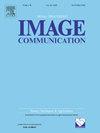Light field video streaming on GPU
IF 2.7
3区 工程技术
Q2 ENGINEERING, ELECTRICAL & ELECTRONIC
引用次数: 0
Abstract
This paper proposes an efficient encoding method for light field video rendering in real time. Each frame of the light field video consists of a grid of images capturing the scene from different camera positions. The images are encoded by a video compression algorithm. The positions of the keyframes on the grid are automatically determined. The proposed compression uses GPU-accelerated HW video decoders. Data transfer between the host and the GPU memory is minimal. Only the packets necessary for the novel view synthesis are transferred. Standard video compression methods need to decode all packets between keyframes, and other existing light field compression methods focus solely on the best compression ratio. The proposed method outperforms them in the quality/decoding time ratio, which is the most important metric for the real-time rendering. The results presented show that currently existing alternatives cannot be used efficiently for 4K light field video streaming. A proof-of-concept light field player was implemented and is available to use. The proposal solves the memory and streaming requirements that are the most crucial issues in light field rendering. The paper additionally outlines enhancements to a current light field rendering technique, which has been modified to integrate effectively with the newly proposed encoding method.

GPU上的光场视频流
提出了一种有效的光场视频实时渲染编码方法。光场视频的每一帧都由从不同摄像机位置捕捉场景的图像网格组成。通过视频压缩算法对图像进行编码。关键帧在网格中的位置是自动确定的。提出的压缩使用gpu加速的HW视频解码器。主机与GPU内存之间的数据传输最少。只传输新视图合成所需的数据包。标准的视频压缩方法需要解码关键帧之间的所有数据包,而其他现有的光场压缩方法只关注最佳压缩比。该方法在质量/解码时间比这一实时渲染最重要的指标上优于它们。结果表明,目前现有的替代方案不能有效地用于4K光场视频流。一个概念验证的光场播放器已经实现并可供使用。该方案解决了光场渲染中最关键的内存和流需求问题。本文还概述了对当前光场渲染技术的改进,该技术已被修改以有效地集成新提出的编码方法。
本文章由计算机程序翻译,如有差异,请以英文原文为准。
求助全文
约1分钟内获得全文
求助全文
来源期刊

Signal Processing-Image Communication
工程技术-工程:电子与电气
CiteScore
8.40
自引率
2.90%
发文量
138
审稿时长
5.2 months
期刊介绍:
Signal Processing: Image Communication is an international journal for the development of the theory and practice of image communication. Its primary objectives are the following:
To present a forum for the advancement of theory and practice of image communication.
To stimulate cross-fertilization between areas similar in nature which have traditionally been separated, for example, various aspects of visual communications and information systems.
To contribute to a rapid information exchange between the industrial and academic environments.
The editorial policy and the technical content of the journal are the responsibility of the Editor-in-Chief, the Area Editors and the Advisory Editors. The Journal is self-supporting from subscription income and contains a minimum amount of advertisements. Advertisements are subject to the prior approval of the Editor-in-Chief. The journal welcomes contributions from every country in the world.
Signal Processing: Image Communication publishes articles relating to aspects of the design, implementation and use of image communication systems. The journal features original research work, tutorial and review articles, and accounts of practical developments.
Subjects of interest include image/video coding, 3D video representations and compression, 3D graphics and animation compression, HDTV and 3DTV systems, video adaptation, video over IP, peer-to-peer video networking, interactive visual communication, multi-user video conferencing, wireless video broadcasting and communication, visual surveillance, 2D and 3D image/video quality measures, pre/post processing, video restoration and super-resolution, multi-camera video analysis, motion analysis, content-based image/video indexing and retrieval, face and gesture processing, video synthesis, 2D and 3D image/video acquisition and display technologies, architectures for image/video processing and communication.
 求助内容:
求助内容: 应助结果提醒方式:
应助结果提醒方式:


